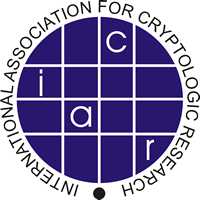Abstract
The \(\texttt {SHA}\text {-} \texttt {3}\) standard consists of four cryptographic hash functions, called SHA3-224, SHA3-256, SHA3-384 and SHA3-512, and two extendable-output functions (XOFs), called SHAKE128 and \(\texttt {SHAKE256}\). In this paper, we study the collision resistance of the \(\texttt {SHA}\text {-} \texttt {3}\) instances. By analyzing the nonlinear layer, we introduce the concept of maximum difference density subspace, and develop a new target internal difference algorithm by probabilistic linearization. We also exploit new strategies for optimizing the internal differential characteristic. Furthermore, we figure out the expected size of collision subsets in internal differentials, by analyzing the collision probability of the digests rather than the intermediate states input to the last nonlinear layer. These techniques enhance the analysis of internal differentials, leading to the best collision attacks on four round-reduced variants of the \(\texttt {SHA}\text {-} \texttt {3}\) instances. In particular, the number of attacked rounds is extended to 5 from 4 for SHA3-384, and to 6 from 5 for \(\texttt {SHAKE256}\).
Supported by the National Natural Science Foundation of China (Grant No. 62122085 and 12231015), the Strategic Priority Research Program of the Chinese Academy of Sciences under Grant XDB0690000 and the Youth Innovation Promotion Association of Chinese Academy of Sciences.
Access this chapter
Tax calculation will be finalised at checkout
Purchases are for personal use only
Similar content being viewed by others
References
Bernstein, D.J.: Second preimages for 6 (7?(8??)) rounds of keccak. NIST mailing list (2010)
Bertoni, G., Daemen, J., Peeters, M., Van Assche, G.: Keccak. In: Johansson, T., Nguyen, P.Q. (eds.) EUROCRYPT 2013. LNCS, vol. 7881, pp. 313–314. Springer, Heidelberg (2013). https://doi.org/10.1007/978-3-642-38348-9_19
Bertoni, G., Daemen, J., Peeters, M., Van Assche, G.: Keccak sponge function family main document. Submission to NIST (Round 2) 3(30), 320–337 (2009)
Chang, D., Kumar, A., Morawiecki, P., Sanadhya, S.K.: 1st and 2nd preimage attacks on 7, 8 and 9 rounds of Keccak-224,256,384,512. In: SHA-3 Workshop (2014)
Dinur, I., Dunkelman, O., Shamir, A.: New attacks on Keccak-224 and Keccak-256. In: Canteaut, A. (ed.) FSE 2012. LNCS, vol. 7549, pp. 442–461. Springer, Heidelberg (2012). https://doi.org/10.1007/978-3-642-34047-5_25
Dinur, I., Dunkelman, O., Shamir, A.: Collision attacks on up to 5 rounds of SHA-3 using generalized internal differentials. In: Moriai, S. (ed.) FSE 2013. LNCS, vol. 8424, pp. 219–240. Springer, Heidelberg (2014). https://doi.org/10.1007/978-3-662-43933-3_12
Dinur, I., Dunkelman, O., Shamir, A.: Improved practical attacks on round-reduced Keccak. J. Cryptol. 27(2), 183–209 (2014). https://doi.org/10.1007/s00145-012-9142-5
Dworkin, M.J.: SHA-3 Standard: Permutation-Based Hash and Extendable-Output Functions (2015). https://doi.org/10.6028/nist.fips.202
Guo, J., Liao, G., Liu, G., Liu, M., Qiao, K., Song, L.: Practical collision attacks against round-reduced SHA-3. J. Cryptol. 33(1), 228–270 (2020). https://doi.org/10.1007/s00145-019-09313-3
Guo, J., Liu, G., Song, L., Tu, Y.: Exploring SAT for cryptanalysis: (quantum) collision attacks against 6-round SHA-3. In: Agrawal, S., Lin, D. (eds.) ASIACRYPT 2022, Part III. LNCS, vol. 13793, pp. 645–674. Springer, Cham (2022). https://doi.org/10.1007/978-3-031-22969-5_22
Guo, J., Liu, M., Song, L.: Linear structures: applications to cryptanalysis of round-reduced Keccak. In: Cheon, J.H., Takagi, T. (eds.) ASIACRYPT 2016. LNCS, vol. 10031, pp. 249–274. Springer, Heidelberg (2016). https://doi.org/10.1007/978-3-662-53887-6_9
Huang, S., Ben-Yehuda, O.A., Dunkelman, O., Maximov, A.: Finding collisions against 4-round SHA-3-384 in practical time. IACR Trans. Symmetric Cryptol. 2022(3), 239–270 (2022). https://doi.org/10.46586/tosc.v2022.i3.239-270
Peyrin, T.: Improved differential attacks for ECHO and Grøstl. In: Rabin, T. (ed.) CRYPTO 2010. LNCS, vol. 6223, pp. 370–392. Springer, Heidelberg (2010). https://doi.org/10.1007/978-3-642-14623-7_20
Qiao, K., Song, L., Liu, M., Guo, J.: New collision attacks on round-reduced Keccak. In: Coron, J.-S., Nielsen, J.B. (eds.) EUROCRYPT 2017, Part III. LNCS, vol. 10212, pp. 216–243. Springer, Cham (2017). https://doi.org/10.1007/978-3-319-56617-7_8
Song, L., Liao, G., Guo, J.: Non-full sbox linearization: applications to collision attacks on round-reduced Keccak. In: Katz, J., Shacham, H. (eds.) CRYPTO 2017, Part II. LNCS, vol. 10402, pp. 428–451. Springer, Cham (2017). https://doi.org/10.1007/978-3-319-63715-0_15
Soos, M., Nohl, K., Castelluccia, C.: Extending SAT solvers to cryptographic problems. In: Kullmann, O. (ed.) SAT 2009. LNCS, vol. 5584, pp. 244–257. Springer, Heidelberg (2009). https://doi.org/10.1007/978-3-642-02777-2_24
Zhang, Z., Hou, C., Liu, M.: Collision attacks on round-reduced SHA-3 using conditional internal differentials. In: Hazay, C., Stam, M. (eds.) EUROCRYPT 2023, Part IV. LNCS, vol. 14007, pp. 220–251. Springer, Cham (2023). https://doi.org/10.1007/978-3-031-30634-1_8
Acknowledgements
We thank the anonymous reviewers from CRYPTO 2024 for their thoughtful comments and insightful questions. Inspired by the reviewers, we were able to optimize the collision attack on 5-round SHA3-384.
Author information
Authors and Affiliations
Corresponding author
Editor information
Editors and Affiliations
1 Electronic supplementary material
Below is the link to the electronic supplementary material.
Rights and permissions
Copyright information
© 2024 International Association for Cryptologic Research
About this paper
Cite this paper
Zhang, Z., Hou, C., Liu, M. (2024). Probabilistic Linearization: Internal Differential Collisions in up to 6 Rounds of SHA-3. In: Reyzin, L., Stebila, D. (eds) Advances in Cryptology – CRYPTO 2024. CRYPTO 2024. Lecture Notes in Computer Science, vol 14923. Springer, Cham. https://doi.org/10.1007/978-3-031-68385-5_8
Download citation
DOI: https://doi.org/10.1007/978-3-031-68385-5_8
Published:
Publisher Name: Springer, Cham
Print ISBN: 978-3-031-68384-8
Online ISBN: 978-3-031-68385-5
eBook Packages: Computer ScienceComputer Science (R0)





